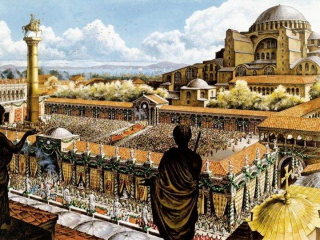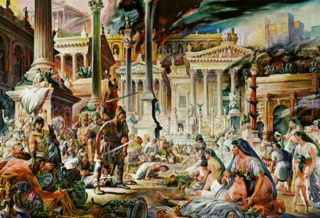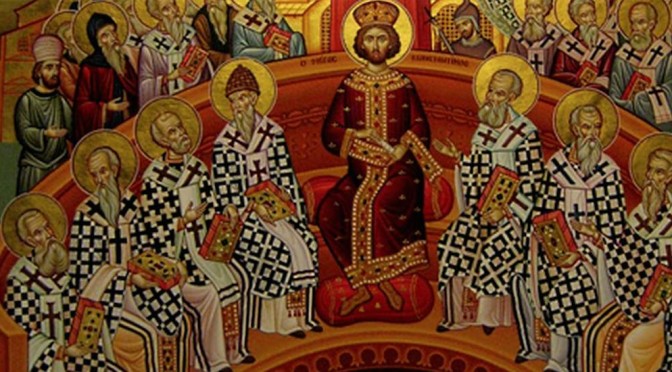Conflict
 The new Roman Capital almost from its inauguration was wracked with religious disputes. The recurring theme was of members of the Church of Rome, or Orthodox Christians attacking other Christians.The new Roman Capital of Constantinople (Byzantium) almost from its inauguration was wracked with religious disputes. The recurring theme was of members of the Church of Rome, or Orthodox Christians attacking other Christians.
The new Roman Capital almost from its inauguration was wracked with religious disputes. The recurring theme was of members of the Church of Rome, or Orthodox Christians attacking other Christians.The new Roman Capital of Constantinople (Byzantium) almost from its inauguration was wracked with religious disputes. The recurring theme was of members of the Church of Rome, or Orthodox Christians attacking other Christians.
To pick out just a sample:-
“On 4th november 512 the fateful phrase, ‘who was crucified for us’ once again echoed through the great basilica. On this occasion the violence was far worse; by the time order had been restored the floor was covered in the blood of the dead and wounded. A similar incident occured the next day at the church of St Theodore resulted in further casualties but on the 6th the orthodox mob was ready. At a huge rally in the Hippodrome they called death and dstruction on all heretics, then poured out into the city to make good their words. Imperial statues were hurled to the ground and smashed; among the many houses burned to the ground were those of the Pretorian Prefect and the Emperor’s nephew Pomeius. The rioting continued for another full two days.”
(from Byzantium, The Early Centuries by John Julius ( Lord )Norwich)
The early machinations of the Church of Rome are really difficult to understand despite the fact that the clash between the trinitarian belief and the Arian belief is well documented.
The documentation as presented to us now is essentially simple, at least with the help of John Julius Norwich it is. Arius was a presbyter not a bishop, but he was acknowledged as being a man of great theological scholarship. The concept he preached was that as Jesus was the son of god there must have been a time he did not exist therefore he was created just like the rest of the human race, he might well have been a man , a very special man but a man nonetheless.
Homoiousis
Mainstream church opinion, though not always clearly articulated was that Jesus was consubstantial with the father. The greek word used to explain this is “homiousios”. Consubstantial though still in use today is not an exact translation as there is no satisfactory equivalent in modern languages. It means the same but different. Perhaps of a similar but different substance.
Nicea
Arius was not alone, he gained support from Eusabius of Caesaria, a most influential bishop of the early church and the majority of easten Bishops. However at the council of Nicea, the first council of the christian church, the majority declared against Arius.
Ten years later, at the Synod of Tyre the Arian beliefs were re-established but Arius died suddenly before he could savour his success. The Arian cause did not end there . For fifty years the debate raged and for several periods Arianism became the approved belief.
Trinitarianism
At the council of Constantinople in AD381 the alternative creed was finally adopted. In an attempt to resolve all disputes amongst non arian bishops the trinity was announced. One god but three persons in one god the father, the son and the holy spirit.
The popular version of events is that the Arians shook their heads and left the empire where their beliefs thrived. Most of the barbarian peoples who surrounded the empire were converted to the Arian faith by the refugees. It cannot have been as simple as that. Only fifty years later those described by the church as “Arian” did not only regard Jesus as a man rather than a god, but they were also dualists, a belief which may have had its origins in Egypt.
The Goths
In the summer and fall of 376, under pressure from the advancing Huns, tens of thousands of displaced Goths crossed the Danube River, on the border of the Roman Empire. The roman emperor, Valens agreed to accept them as he planned to use them to increase the size of his army. They came with an impediment, they believed in a different form of christianity. They were said to be Arian,whose main difference from orthodoxy was a theological concern about the nature of Jesus, but they were known to be something else as well Dualists, they believed in two gods. The subsequent history of the Goths suggests that they were Cathars.
 In the summer and fall of 376, under pressure from the advancing Huns, tens of thousands of displaced Goths crossed the Danube River, on the border of the Roman Empire. The roman emperor, Valens agreed to accept them as he planned to use them to increase the size of his army. They came with an impediment, they believed in a different form of christianity. They were said to be Arian,whose main difference from orthodoxy was a theological concern about the nature of Jesus, but they were known to be something else as well Dualists, they believed in two gods. The subsequent history of the Goths suggests that they were Cathars.
In the summer and fall of 376, under pressure from the advancing Huns, tens of thousands of displaced Goths crossed the Danube River, on the border of the Roman Empire. The roman emperor, Valens agreed to accept them as he planned to use them to increase the size of his army. They came with an impediment, they believed in a different form of christianity. They were said to be Arian,whose main difference from orthodoxy was a theological concern about the nature of Jesus, but they were known to be something else as well Dualists, they believed in two gods. The subsequent history of the Goths suggests that they were Cathars.
Attempts to convert the Goths were strenuously resisted and so a program of discrimination commenced. Rome failed to supply them with either the food they were promised or lands they could farm; they herded the Goths into a temporary holding area surrounded by an armed Roman garrison and left the the Goths to starve. The Romans provided a grim alternative: the trade of slaves (often children and young women) for dog meat. The Romans provided the male Goths with paid service in the army but then used them continually in the front line holding the legions in reserve. there seemed to be no concern for Gothic losses and worse still their women and children still in the guarded camp were subject to brutality and rape. Open revolt began.
After an open war lasting six years in which they defeated Valens and occupied most of Illyrica (Serbia and Croatia) the Goths made peace and settled into lands close to the Danube but under substantially better conditions. They still suffered discrimination and sporadic attacks.
They Served in the roman army but were still discriminated against. Eventually the decision was take to move to an are where the poulace shared the same religious beliefs, the area they chose was Occitan. On the way there, they conducted extended negotiations with The Emperor and senate of Rome. They wanted to be made autonomous by a grant of land away from the Danube, monetary compensation for their suffering, and access to the Roman grain from North Africa. The negotiations ended in 410 with the Gothic occupation of Rome, which has become notorious as “The Sack of Rome”.
[tab title=”New Home”]They settled into a new home on the atlantic coast initially on the banks of the river Garronne and created a new kingdom which eventually stretched from the Loire river to the straights of Gibraltar, (modern Aquitaine, Haut Garonne, Languedoc, Provence, Roussillon, Catalonia and Spain. This suggests that the form of Christianity they found there was indeed compatible with, or tolerant of their own beliefs.
[/tab] [tab title=”Beliefs”]The Goth’s religion was labeled by the Church of Rome as “Arian” but it was more than that. It incorporated the teachings of Mani. Manichaeist Christianity had thrived beyond the eastern boundary of the Roman Empire. In Manichaeism there were two Gods, a Good God called simply God, Good God, Pleroma, Bythos, Amun or Mazda and a Bad God, Demoniac, Demiurge or Yahweh. It identified itself as Christian but traces can be seen of Zoroastrian, Gnostic and Buddhist beliefs. The word Mazda for the Good God originated in the Zoroastrian, and Gnostic beliefs and both, in turn, drew on both Egyptian and Greek traditions. Some believe that Islam was a product of the Manichaeist beliefs and therefore might have had some affinity with the Goths.
